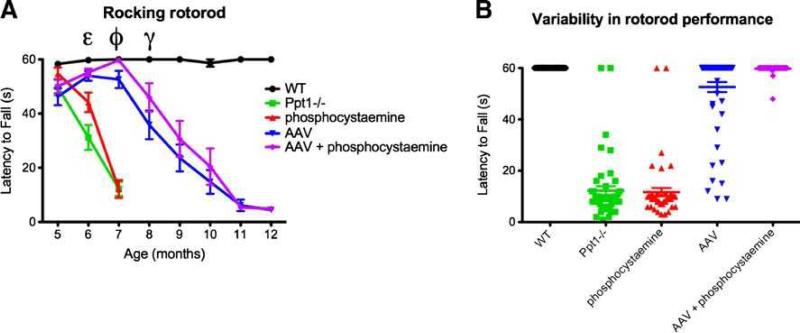Fig. 5a, b.
Functional improvement on the rocking rotorod paradigm. a Motor improvement observed following therapeutic intervention. At 5 months of age, all treated and untreated mice performed similarly on the rocking rotorod paradigm. At 6 months, the performance of the phosphocysteamine only and untreated Ppt1-/- mice began to deteriorate and was significantly worse compared to WTcontrols (p<0.0001). Phosphocysteamine-treated mutant mice performed better at 6 months of age compared to untreated Ppt1-/- mice (ε). Remarkably, the performance of the AAV only or AAV+phosphocysteamine treated–mice was comparable to W T. The motor function of both phosphocysteamine-treated and untreated Ppt1-/- mice deteriorated dramatically by 7 months of age. At 7 months, AAV+phosphocysteamine–treated mice not only performed significantly better than AAV only–treated mice (p<0.001), but the motor performance of the combination group was indistinguishable from WT (ϕ). At 8 months, motor function in AAV only and AAV+phosphocysteamine–treated mice began to decline, but the performance of the AAV+phophocysteamine treatment group was still significantly improved compared to AAV only–treated mutant mice (γ; p<0.05). Motor performance continued to decline in both the AAVonly and AAV+ phophocysteamine–treated mice until they were unable to accomplish this task at 12 months of age. b Scatter plot of rocking rotorod data for 7-month-old mice. Each point represents an individual trial for each mouse tested within each treatment group. In the WT group, all mice stayed on the rod for 60 s. In comparison, the phosphocysteamine and untreated Ppt1-/- mice performed poorly, and each individual trial clustered around 10 s. Of particular interest is the comparison between the AAV only and AAV+phosphocysteamine groups. The variability within the AAV only treatment group was far greater than the AAV+phosphocysteamine group, suggesting that combination therapy was more effective than AAV treatment alone

